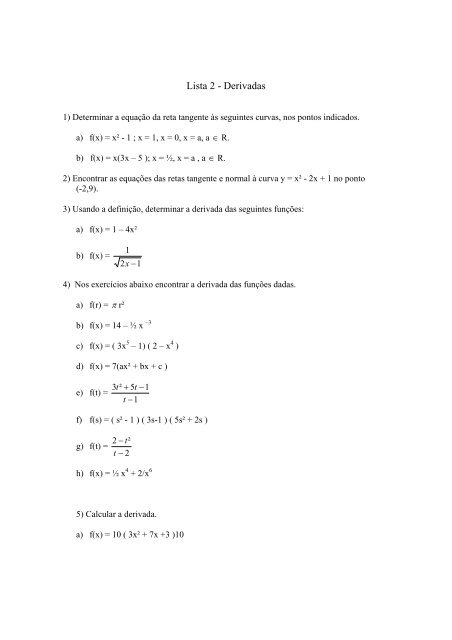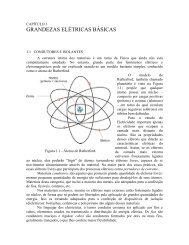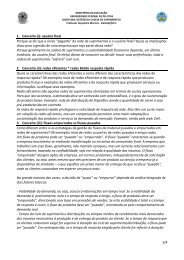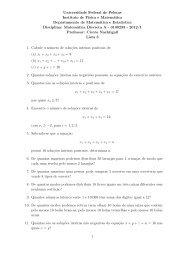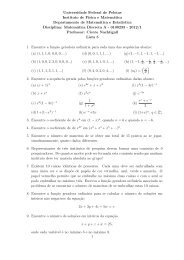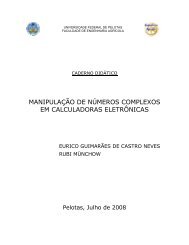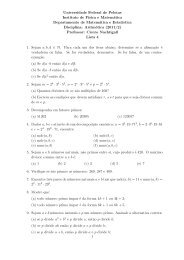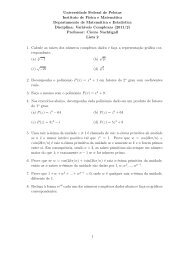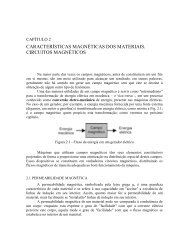Lista 2 - Derivadas - Minerva.ufpel.tche.br
Lista 2 - Derivadas - Minerva.ufpel.tche.br
Lista 2 - Derivadas - Minerva.ufpel.tche.br
You also want an ePaper? Increase the reach of your titles
YUMPU automatically turns print PDFs into web optimized ePapers that Google loves.
<strong>Lista</strong> 2 - <strong>Derivadas</strong><<strong>br</strong> />
1) Determinar a equação da reta tangente às seguintes curvas, nos pontos indicados.<<strong>br</strong> />
a) f(x) = x² - 1 ; x = 1, x = 0, x = a, a ∈ R.<<strong>br</strong> />
b) f(x) = x(3x – 5 ); x = ½, x = a , a ∈ R.<<strong>br</strong> />
2) Encontrar as equações das retas tangente e normal à curva y = x² - 2x + 1 no ponto<<strong>br</strong> />
(-2,9).<<strong>br</strong> />
3) Usando a definição, determinar a derivada das seguintes funções:<<strong>br</strong> />
a) f(x) = 1 – 4x²<<strong>br</strong> />
b) f(x) =<<strong>br</strong> />
1<<strong>br</strong> />
2x<<strong>br</strong> />
−1<<strong>br</strong> />
4) Nos exercícios abaixo encontrar a derivada das funções dadas.<<strong>br</strong> />
a) f(r) = π r²<<strong>br</strong> />
b) f(x) = 14 – ½ x –3<<strong>br</strong> />
c) f(x) = ( 3x 5 – 1) ( 2 – x 4 )<<strong>br</strong> />
d) f(x) = 7(ax² + bx + c )<<strong>br</strong> />
e) f(t) =<<strong>br</strong> />
3t²<<strong>br</strong> />
+ 5t<<strong>br</strong> />
−1<<strong>br</strong> />
t −1<<strong>br</strong> />
f) f(s) = ( s² - 1 ) ( 3s-1 ) ( 5s² + 2s )<<strong>br</strong> />
g) f(t) =<<strong>br</strong> />
2 − t²<<strong>br</strong> />
t − 2<<strong>br</strong> />
h) f(x) = ½ x 4 + 2/x 6<<strong>br</strong> />
5) Calcular a derivada.<<strong>br</strong> />
a) f(x) = 10 ( 3x² + 7x +3 )10
) f(x) = 3 3x<<strong>br</strong> />
² 6 2)²<<strong>br</strong> />
( + x −<<strong>br</strong> />
7x²<<strong>br</strong> />
c) f(x) = + 3x<<strong>br</strong> />
+ 1<<strong>br</strong> />
5 2(<<strong>br</strong> />
3x<<strong>br</strong> />
+ 1)<<strong>br</strong> />
3x² + 6x + 7<<strong>br</strong> />
d) f(x) = 2e<<strong>br</strong> />
3x<<strong>br</strong> />
a<<strong>br</strong> />
6<<strong>br</strong> />
e) f(x) = 3x<<strong>br</strong> />
² − x<<strong>br</strong> />
b<<strong>br</strong> />
In(a + bs)<<strong>br</strong> />
f) f(s) = ½ (a+bs)<<strong>br</strong> />
g) f(x) = sen³(3x² + 6x)<<strong>br</strong> />
h) f(t) =<<strong>br</strong> />
e<<strong>br</strong> />
e<<strong>br</strong> />
t<<strong>br</strong> />
t<<strong>br</strong> />
−1<<strong>br</strong> />
+ 1<<strong>br</strong> />
i) f(x) = 1/a (bx² + c) – Inx<<strong>br</strong> />
j) f(x) = sen² x + cos² x<<strong>br</strong> />
k) f(x) = e 2x cos 3x<<strong>br</strong> />
l) f(x) = sen² (x/2)cos² (x/2)<<strong>br</strong> />
m) f(x) = log2 ( 3x – cos 2x )<<strong>br</strong> />
2 cos 2t<<strong>br</strong> />
n) f(t) = e<<strong>br</strong> />
6) Nos exercícios abaixo calcular as derivadas sucessivas até a ordem n indicada.<<strong>br</strong> />
a) y = 3x 4 – 2x; n=5<<strong>br</strong> />
b) y = 1/e x ; n = 4


